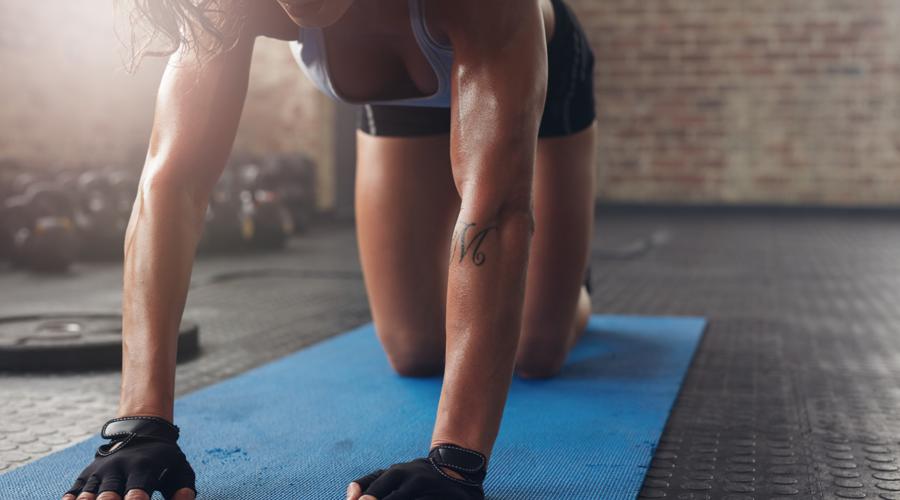
Have you ever wondered which exercise burns more calories: burpees or running? Both exercises are popular and effective for getting your heart rate up, building endurance, and burning fat. But when it comes to weight loss, which is the better choice?
Burpees are a full-body exercise that targets multiple muscle groups at once, including the chest, shoulders, arms, core, and legs. It’s a high-intensity exercise that involves squatting, jumping, and push-ups, making it a challenging yet rewarding exercise. Running, on the other hand, is a classic form of cardio that requires nothing but a good pair of shoes and some open space. It’s an excellent exercise for building endurance, improving cardiovascular health, and burning calories.
In this post, we’ll take a closer look at the benefits of both exercises and compare their calorie-burning potential. We’ll explore the science behind each exercise and examine how they impact your body’s metabolism. By the end of this post, you’ll have a better understanding of which exercise is best for achieving your weight loss goals. So, whether you’re a burpee enthusiast or a running aficionado, keep reading to find out which exercise burns more calories!
What are Burpees?
Burpees are a full-body exercise that combines several movements into one fluid motion. The basic burpee involves the following steps:
- Begin in a standing position with your feet shoulder-width apart.
- Lower your body into a squatting position and place your hands on the ground in front of you.
- Kick your feet back, so that you are in a plank position.
- Lower your body down to the ground, so that your chest touches the floor.
- Push your body up off the ground, returning to the plank position.
- Jump your feet back up to your hands, returning to the squatting position.
- Jump up as high as you can, reaching your arms overhead.
The burpee is often used in high-intensity interval training (HIIT) workouts, as it provides a full-body workout and gets your heart rate up quickly. It can be modified to suit different fitness levels and can be done without any equipment, making it a convenient exercise to do at home or while traveling.
Read more about Calisthenics

What is Running?
Running is a form of aerobic exercise that involves moving rapidly on foot. It is a popular form of cardiovascular exercise that can be done anywhere and requires little to no equipment. Running can range from a slow jog to a sprint and can be done at different intensities and distances.
Running has numerous health benefits, including improved cardiovascular health, weight loss, improved bone density, and reduced risk of chronic diseases such as diabetes and high blood pressure. Running is also a great stress reliever and can improve overall mood and mental health.
While running is a high-impact exercise that can be hard on the joints, proper footwear, good form, and gradually increasing intensity and distance can help prevent injury. Running can be done alone or with a group, and there are many resources available to help beginners get started with a running routine.
Burpees vs Running Comparison
Muscles Worked
Burpees and running engage different muscle groups in the body. Burpees are a full-body exercise that targets multiple muscle groups at once, including the chest, shoulders, arms, core, and legs. The squatting motion works the glutes, hamstrings, and quadriceps, while the push-up works the chest, triceps, and shoulders. The jumping motion engages the calves and the core muscles stabilize the body during the entire exercise. Overall, burpees provide a high-intensity full-body workout that can improve strength and endurance.
Running primarily works the lower body muscles, including the quadriceps, hamstrings, glutes, and calves. Running also engages the core muscles for stabilization and balance. The muscles in the legs and lower body are used in a repetitive motion, which can lead to muscle fatigue and soreness. However, consistent running can also lead to improved muscle endurance and strength in the lower body.
Cardiovascular Benefits
Both burpees and running provide excellent cardiovascular benefits. Burpees are a high-intensity exercise that can quickly get the heart rate up and provide a cardio workout. The combination of squatting, jumping, and push-ups provides a challenge to the body and can lead to improved cardiovascular endurance.
Running is a classic form of cardio that has been shown to improve cardiovascular health, reduce the risk of heart disease, and lower blood pressure. Running can also improve lung capacity and oxygen uptake, which can lead to improved overall health and fitness.
Both burpees and running can be incorporated into a cardio workout routine to improve cardiovascular endurance.
Calorie Burn
Burpees and running both provide a high calorie-burning workout. The exact number of calories burned depends on factors such as body weight, intensity, duration, and frequency of exercise. However, generally speaking, both burpees and running can burn a significant number of calories per session.
Burpees are a high-intensity exercise that engages multiple muscle groups, making them an effective calorie-burning exercise. Running is a great cardio workout that can burn calories quickly and efficiently.
The exact number of calories burned during burpees and running can vary depending on the intensity and duration of the exercise. However, both exercises can be effective for weight loss and improving overall fitness.
Impact on Joints
Burpees and running have different impacts on the joints. Burpees are a high-impact exercise that can be hard on the joints, particularly the knees and wrists. The jumping motion and impact of landing can cause strain and impact on the joints, making burpees a challenging exercise for those with joint pain or injury.
Running is also a high-impact exercise that can put strain on the joints, particularly the knees and ankles. However, proper footwear and good form can help reduce the impact on the joints and prevent injury. Running can also be modified to include lower-impact exercises such as walking or jogging.
Overall, both burpees and running have a high impact on the joints and can be challenging for those with joint pain or injury. However, proper form and modifications can help reduce the impact and prevent injury.
Read more about Burpees vs Running

Intensity and Difficulty
Burpees and running are both high-intensity exercises that can be challenging for beginners. Burpees require a combination of strength and cardio endurance and can be difficult for those who are not used to the exercise. Burpees can also be modified to suit different fitness levels, making them a versatile exercise.
Running also requires endurance and can be challenging for beginners, particularly when running at a faster pace or longer distance. However, running can be modified to include walking or slower jogging, making it accessible for different fitness levels.
Overall, both burpees and running require a certain level of fitness and can be challenging for beginners. However, both exercises can be modified to suit different fitness levels and can be gradually increased in intensity and difficulty over time.
Time and Equipment Requirements
Burpees and running have different time and equipment requirements. Burpees can be done anywhere and require no equipment, making them a convenient exercise to do at home or while traveling. Burpees can be done in a short amount of time, making them a time-efficient exercise.
Running requires minimal equipment, typically just a good pair of running shoes. Running can be done anywhere and can be incorporated into a daily routine, making it a convenient exercise option. Running typically requires more time than burpees, as it takes longer to cover distance than it does to perform a set of burpees.
Overall, burpees are a convenient exercise that requires no equipment and can be done in a short amount of time. Running requires minimal equipment and can be incorporated into a daily routine but typically requires more time than burpees. Both exercises can be effective for improving fitness and can be incorporated into a well-rounded workout routine.
Common Mistakes and Tips for Better Results
To get the most out of burpees and running, it’s important to perform the exercises correctly and avoid common mistakes that can lead to injury or reduced effectiveness. Here are some tips for avoiding common mistakes and getting better results:
Burpees
- Using improper form: Ensure that you are keeping your back straight, engaging your core, and keeping your elbows close to your body during the push-up portion of the exercise. This will help prevent injury and ensure you are getting the most out of the exercise.
- Rushing through the exercise: Take your time and focus on proper form rather than rushing through the exercise. This will help ensure that you are engaging the proper muscles and reducing the risk of injury.
- Not modifying the exercise: Burpees can be modified to suit different fitness levels. If the full burpee is too challenging, modify the exercise by eliminating the push-up or jumping portion of the exercise.
Running
- Wearing improper footwear: Proper running shoes can help reduce the risk of injury and improve performance. Ensure that your shoes are comfortable, supportive, and fit properly.
- Starting too fast: Gradually build up your endurance and pace to avoid injury and reduce the risk of burnout. Start with a slow jog or walk and gradually increase your speed and distance.
- Neglecting rest and recovery: Rest days are important for recovery and to prevent injury. Make sure to incorporate rest days into your routine and stretch or do yoga on those days to improve flexibility and prevent injury.
Overall, proper form, gradual progression, and rest and recovery are important for getting the most out of burpees and running. By avoiding common mistakes and incorporating these tips, you can improve your performance and reduce the risk of injury.
Read more about 100 Burpees a Day Challenge

Burpees vs Running: Which Exercise is Best for You?
When it comes to choosing between burpees vs running, the answer depends on your fitness goals, preferences, and overall health. Here are some factors to consider when deciding which exercise is best for you:
Fitness Goals
- If you want to improve overall strength and endurance, burpees can provide a full-body workout that targets multiple muscle groups.
- If you want to improve cardiovascular health, running is a classic form of cardio that can improve heart health, lung capacity, and overall endurance.
- If you want to lose weight or burn calories, both burpees and running can be effective calorie-burning exercises when done at the proper intensity and duration.
Preferences
- If you enjoy variety in your exercise routine, incorporating both burpees and running can provide a well-rounded workout.
- If you prefer a quick and convenient exercise that requires no equipment, burpees can be done anywhere and at any time.
- If you enjoy being outside and exploring new areas, running can be a great way to get some fresh air and see new sights.
Overall Health
- If you have joint pain or injuries, burpees may be more challenging as they are a high-impact exercise that can be hard on the joints.
- If you have respiratory issues, running may be more challenging as it can put strain on the lungs and require more oxygen uptake.
- If you have any health concerns or conditions, it’s important to consult with a healthcare professional before starting any new exercise routine.
Ultimately, the best exercise for you is the one that you enjoy and can consistently incorporate into your routine. Both burpees and running can provide excellent health benefits and can be modified to suit different fitness levels and goals. By considering your fitness goals, preferences, and overall health, you can choose the exercise that works best for you.